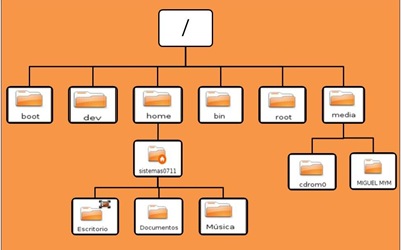 In Linux anything is treated as a file, from our personal files to hardware devices printer, mouse, storage devices, etc.. A This is called file system, the systems are Linux native ext2 or ext3 (Ubuntu is installed on ext3), but GNU / Linux is able to work with different types (including FAT and NTFS).
In Linux anything is treated as a file, from our personal files to hardware devices printer, mouse, storage devices, etc.. A This is called file system, the systems are Linux native ext2 or ext3 (Ubuntu is installed on ext3), but GNU / Linux is able to work with different types (including FAT and NTFS).
♦ This is the tree of files in Windows XP:
♦ This is the tree of files in Linux:
Here are some of the basic files to understand the logic of the system are:
- / bin: contains the executable (binary) essential for the system. Looking at the topics covered include the most basic commands.
- / boot: Here are the files used by the system at boot time, including the kernel image.
- / dev: Store drivers (device drivers and device files) for access to physical disk devices such as mouse, cards, scanners, etc..
- / var: Contains information variable, both generated by the system as users.
- / lib: Contains libraries used different applications for each program include preventing their own, thus avoiding redundancy.
- / etc: Directory used to store all system configuration files.
- / home: contains the directory tree of each system user. You will find a subdirectory for each user to safeguard the confidentiality of the data for each user. It is recommended to install on a different partition to save data in the event of a system reinstallation.
- / sbin: Here are the essential commands of system administration, usually reserved for the administrator.
- / usr: applications are stored here and available resources to all users of the system.
- / tmp: temporary directory is usually used by applications to store some files at runtime.
- / media: down here where you files automatically mount removable drives such as cdrom, usb.
♦ / media/cdrom0: For the first cdrom drive.
♦ / media / usbdisk: For usb memory.
♦ / media / floppy: to the diskette.

0 comments:
Post a Comment